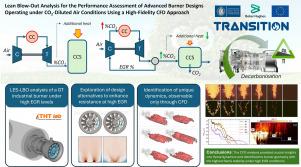Lean Blow-Out analysis for the performance assessment of advanced burner designs operating under CO2-diluted air conditions using a high-fidelity CFD approach
IF 5
Q2 ENERGY & FUELS
引用次数: 0
Abstract
Amid the growing focus on sustainable industrial practices, Carbon Capture and Storage (CCS) systems are becoming increasingly essential for reducing the carbon footprint of Gas Turbine (GT) power generation. In this context, an efficient GT-CCS coupling can be achieved by employing high Exhaust Gas Recirculation (EGR) rates to boost CO2 content at the CCS inlet. However, the reduced oxygen levels resulting from these operating conditions pose significant challenges to conventional combustion systems, limiting flame stability and, consequently, engine operability. Overcoming these challenges requires the development of novel technical solutions aimed at enhancing combustor performance under high EGR rates.
Computational Fluid Dynamics (CFD) is crucial in this endeavour offering detailed analysis of intricate flow behaviours, mixing process dynamics, flame structures, and stability thresholds within the combustor. Given the demand for extensive simulations to assess flame stability across various burner designs and operating conditions, balancing the necessity for high accuracy while keeping computational expenses in check is mandatory.
This study employs a high-fidelity CFD approach to perform a comprehensive Lean Blow-Out (LBO) analysis, with the goal of identifying burner designs that exhibit broader operability limits under highly CO2-diluted air conditions, which emulate the effects of a real EGR system. All simulations utilise an extended Flamelet Generated Manifold (FGM) turbulent combustion model, whose accuracy and cost-effectiveness have been previously validated by the authors.
The numerical results demonstrate the capability of CFD to identify unique blow-off dynamics that are challenging to observe experimentally. Additionally, the findings highlight the most effective design strategy for extending the flame stability range under high EGR levels.

采用高保真CFD方法对在二氧化碳稀释空气条件下运行的先进燃烧器设计进行Lean Blow-Out分析
随着对可持续工业实践的日益关注,碳捕获和储存(CCS)系统对于减少燃气轮机(GT)发电的碳足迹变得越来越重要。在这种情况下,通过采用高废气再循环(EGR)速率来提高CCS入口的二氧化碳含量,可以实现高效的GT-CCS耦合。然而,这些操作条件导致的氧气水平降低对传统燃烧系统构成了重大挑战,限制了火焰稳定性,从而影响了发动机的可操作性。克服这些挑战需要开发新的技术解决方案,旨在提高高EGR率下燃烧室的性能。计算流体动力学(CFD)在这项工作中至关重要,它提供了对燃烧室内复杂流动行为、混合过程动力学、火焰结构和稳定性阈值的详细分析。考虑到需要广泛的模拟来评估各种燃烧器设计和操作条件下的火焰稳定性,平衡高精度的必要性,同时保持计算费用的控制是强制性的。本研究采用高保真CFD方法进行了全面的精益吹出(LBO)分析,目的是确定在高度二氧化碳稀释的空气条件下具有更广泛可操作性限制的燃烧器设计,以模拟真实EGR系统的效果。所有的模拟都使用了一个扩展的火焰生成歧管(FGM)湍流燃烧模型,其准确性和成本效益已经得到了作者的验证。数值结果表明,CFD能够识别出难以通过实验观察到的独特的吹出动力学。此外,研究结果强调了在高EGR水平下延长火焰稳定范围的最有效设计策略。
本文章由计算机程序翻译,如有差异,请以英文原文为准。
求助全文
约1分钟内获得全文
求助全文

 求助内容:
求助内容: 应助结果提醒方式:
应助结果提醒方式:


